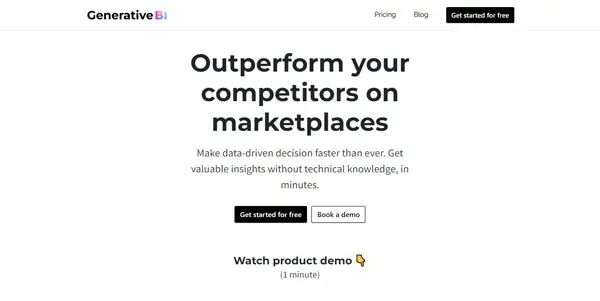Generative BI

Receive complex information and make better decisions for your business
Generative BI: Revolutionizing Business Decision-Making with AI
Generative Business Intelligence (Generative BI) tools represent a significant advancement in data analysis and decision-making. These AI-powered platforms go beyond traditional BI by not only analyzing existing data but also generating insights, predictions, and even complete reports autonomously. Instead of simply presenting raw data, Generative BI helps users receive complex information in a digestible format, leading to better, more informed business decisions. This article will explore the capabilities, benefits, applications, and comparisons of Generative BI tools, specifically within the context of those categorized as RIP AI (presumably referring to a specific vendor classification). Note that the specific features and capabilities may vary based on the particular vendor and its offering.
What Generative BI Does
Generative BI tools leverage advanced AI techniques, such as natural language processing (NLP), machine learning (ML), and deep learning, to analyze massive datasets and extract actionable intelligence. Unlike traditional BI tools that rely heavily on pre-defined queries and reports, Generative BI allows users to interact with data using natural language. Users can ask questions in plain English, and the system will autonomously generate insights, predictions, and visualizations tailored to the query. This empowers users to explore data more intuitively and discover hidden patterns and relationships that might be missed using traditional methods.
Main Features and Benefits
Key features of Generative BI tools typically include:
- Natural Language Querying: Ask questions in plain language to retrieve insights.
- Automated Report Generation: The system automatically creates comprehensive reports based on the data and user queries.
- Predictive Analytics: Forecast future trends and outcomes based on historical data patterns.
- Data Visualization: Present complex information clearly and concisely through intuitive charts and graphs.
- Anomaly Detection: Identify unusual patterns or outliers in the data that may indicate problems or opportunities.
- Explainable AI (XAI): Provides insights into how the AI arrived at its conclusions, building trust and transparency.
- Integration with Existing Systems: Seamlessly integrates with existing data sources and business intelligence platforms.
The benefits of using Generative BI include:
- Increased Efficiency: Automate report generation and analysis, freeing up time for strategic decision-making.
- Improved Insights: Uncover hidden patterns and trends that might be missed with traditional methods.
- Faster Decision-Making: Access timely and relevant insights to make informed decisions quickly.
- Enhanced Collaboration: Share insights easily with colleagues through interactive dashboards and reports.
- Reduced Costs: Optimize resource allocation and improve operational efficiency.
Use Cases and Applications
Generative BI finds applications across numerous business domains:
- Marketing: Analyze customer behavior to personalize marketing campaigns, predict customer churn, and optimize advertising spend.
- Sales: Identify high-potential leads, forecast sales performance, and improve sales strategies.
- Finance: Detect fraudulent transactions, manage risk effectively, and optimize financial planning.
- Operations: Improve supply chain efficiency, optimize resource allocation, and predict equipment maintenance needs.
- Human Resources: Analyze employee data to identify trends, improve recruitment strategies, and enhance employee engagement.
Comparison to Similar Tools
While Generative BI shares similarities with traditional BI tools and other AI-powered analytics platforms, it distinguishes itself through its generative capabilities. Traditional BI requires users to formulate specific queries and interpret the results. Other AI tools might offer predictive analytics but lack the natural language interface and automated report generation capabilities central to Generative BI. The key differentiator is the ability to generate comprehensive insights and reports automatically in response to simple questions, eliminating the need for extensive technical expertise.
Pricing Information
Generative BI tools, categorized as RIP AI, are typically offered on a paid subscription basis. Specific pricing models vary depending on factors such as the number of users, data volume, and features included. Contact the specific RIP AI vendor for detailed pricing information. It's important to request a detailed breakdown of costs and to compare different offerings before selecting a solution.
Disclaimer: This article provides general information on Generative BI tools. Specific features, functionalities, and pricing may vary depending on the provider. Always consult the vendor's documentation and pricing information for accurate details.